
Santiago de los Caballeros de Guatemala ("St. James of the Knights of Guatemala") was the name given to the capital city of the Spanish colonial Captaincy General of Guatemala in Central America.

Santiago de los Caballeros de Guatemala ("St. James of the Knights of Guatemala") was the name given to the capital city of the Spanish colonial Captaincy General of Guatemala in Central America.

Pedro de Alvarado was a Spanish conquistador and governor of Guatemala. He participated in the conquest of Cuba, in Juan de Grijalva's exploration of the coasts of the Yucatán Peninsula and the Gulf of Mexico, and in the conquest of the Aztec Empire led by Hernán Cortés. He is considered the conquistador of much of Central America, including Guatemala, Honduras and El Salvador.

Antigua Guatemala, commonly known as Antigua or La Antigua, is a city in the central highlands of Guatemala. The city was the capital of the Captaincy General of Guatemala from 1543 through 1773, with much of its Baroque-influenced architecture and layout dating from that period. These characteristics had it designated as a UNESCO World Heritage Site in 1979. Antigua Guatemala serves as the capital of the homonymous municipality and the Sacatepéquez Department.

Sacatepéquez is one of the 22 departments of Guatemala. The name comes from Sacatepéquez, a city from November 21, 1542, until July 29, 1773, when it was destroyed by the 1773 Guatemalan Earthquake. Sacatepéquez means grasshill in the Nahuatl language. The capital of Sacatepéquez is Antigua Guatemala. Other important cities include Ciudad Vieja and San Lucas Sacatepéquez, which also hosts a marketplace and is a culinary attraction. The Chajoma were a group of indigenous people who were Kaqchikel speaking Indians identified Mixco Viejo as their capital, and spread throughout the Sacatepequez Department until their capital was moved to Ciudad Vieja, in Antigua.
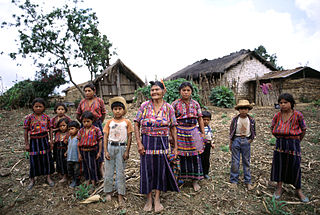
The Kaqchikel are one of the indigenous Maya peoples of the midwestern highlands of Guatemala and of southern Mexico. They constitute Guatemala's third largest Maya group. The name was formerly spelled in various other ways, including Cakchiquel, Kakchiquel, Caqchikel, and Cachiquel.
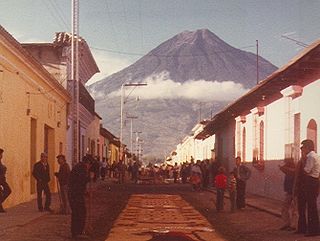
Volcán de Agua is an extinct stratovolcano located in the departments of Sacatepéquez and Escuintla in Guatemala. At 3,760 m (12,340 ft), Agua Volcano towers more than 3,500 m (11,500 ft) above the Pacific coastal plain to the south and 2,000 m (6,600 ft) above the Guatemalan Highlands to the north. It dominates the local landscape except when hidden by cloud cover. The volcano is within 5 to 10 km of the city of Antigua Guatemala and several other large towns situated on its northern apron. These towns have a combined population of nearly 100,000. It is within about 20 km (12 mi) of Escuintla to the south. Coffee is grown on the volcano's lower slopes.

In a protracted conflict during the Spanish colonization of the Americas, Spanish colonisers gradually incorporated the territory that became the modern country of Guatemala into the colonial Viceroyalty of New Spain. Before the conquest, this territory contained a number of competing Mesoamerican kingdoms, the majority of which were Maya. Many conquistadors viewed the Maya as "infidels" who needed to be forcefully converted and pacified, disregarding the achievements of their civilization. The first contact between the Maya and European explorers came in the early 16th century when a Spanish ship sailing from Panama to Santo Domingo was wrecked on the east coast of the Yucatán Peninsula in 1511. Several Spanish expeditions followed in 1517 and 1519, making landfall on various parts of the Yucatán coast. The Spanish conquest of the Maya was a prolonged affair; the Maya kingdoms resisted integration into the Spanish Empire with such tenacity that their defeat took almost two centuries.

Ciudad Vieja is a town and municipality in the Guatemalan department of Sacatepéquez. According to the 2018 census, the town has a population of 32,802 and the municipality a population of 33,405. Ciudad Vieja was the second site of Santiago de los Caballeros de Guatemala, the colonial capital of the country.

Jocotenango is a town and small municipality in the northeast section of Guatemalan department of Sacatepéquez, and is situated north of Antigua Guatemala. It has seven zones, two villages, and one hamlet. According to the 2018 census, the municipality has a total population of 21,657 of which 1,680 are native population and the balance are non-indigenous; and approximately 19,280 live in an urban area, while the balance are rural dwellers.
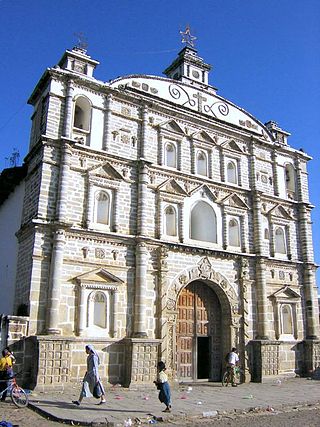
Zacualpa is a town and municipality in the Guatemalan department of El Quiché.
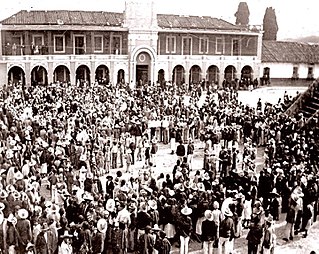
Tecpán is a town, with a population of 34,519, and a municipality in the department of Chimaltenango, in Guatemala, on the Inter-American Highway CA-1.

The Captaincy General of Guatemala, also known as the Kingdom of Guatemala, was an administrative division of the Spanish Empire, under the viceroyalty of New Spain in Central America, including the present-day nations of Costa Rica, Nicaragua, Honduras, El Salvador, and Guatemala, and the Mexican state of Chiapas. The governor-captain general was also president of the Royal Audiencia of Guatemala, the superior court.

The Annals of the Cakchiquels is a manuscript written in Kaqchikel by Francisco Hernández Arana Xajilá in 1571, and completed by his grandson, Francisco Rojas, in 1604. The manuscript — which describes the legends of the Kaqchikel nation and has historical and mythological components — is considered an important historical document on post-classic Maya civilization in the highlands of Guatemala.

Iximcheʼ is a Pre-Columbian Mesoamerican archaeological site in the western highlands of Guatemala. Iximche was the capital of the Late Postclassic Kaqchikel Maya kingdom from 1470 until its abandonment in 1524. The architecture of the site included a number of pyramid-temples, palaces and two Mesoamerican ballcourts. Excavators uncovered the poorly preserved remains of painted murals on some of the buildings and ample evidence of human sacrifice. The ruins of Iximche were declared a Guatemalan National Monument in the 1960s. The site has a small museum displaying a number of pieces found there, including sculptures and ceramics. It is open daily.

The Spanish conquest of the Maya was a protracted conflict during the Spanish colonisation of the Americas, in which the Spanish conquistadores and their allies gradually incorporated the territory of the Late Postclassic Maya states and polities into the colonial Viceroyalty of New Spain. The Maya occupied the Maya Region, an area that is now part of the modern countries of Mexico, Guatemala, Belize, Honduras and El Salvador; the conquest began in the early 16th century and is generally considered to have ended in 1697.

The Chajoma were a Kaqchikel-speaking Maya people of the Late Postclassic period, with a large kingdom in the highlands of Guatemala. According to the indigenous chronicles of the K'iche' and the Kaqchikel, there were three principal Postclassic highland kingdoms; the K'iche', the Kaqchikel and the Chajoma. In the Annals of the Cakchiquels the Chajoma of Jilotepeque were always referred to as the akajal vinak, in the Popul Vuh these can probably be identified with the akul vinak. Both akajal vinak and akul vinak mean "the bee people" or "the hive people".

Maya cities were the centres of population of the pre-Columbian Maya civilization of Mesoamerica. They served the specialised roles of administration, commerce, manufacturing and religion that characterised ancient cities worldwide. Maya cities tended to be more dispersed than cities in other societies, even within Mesoamerica, as a result of adaptation to a lowland tropical environment that allowed food production amidst areas dedicated to other activities. They lacked the grid plans of the highland cities of central Mexico, such as Teotihuacán and Tenochtitlan. Maya kings ruled their kingdoms from palaces that were situated within the centre of their cities. Cities tended to be located in places that controlled trade routes or that could supply essential products. This allowed the elites that controlled trade to increase their wealth and status. Such cities were able to construct temples for public ceremonies, thus attracting further inhabitants to the city. Those cities that had favourable conditions for food production, combined with access to trade routes, were likely to develop into the capital cities of early Maya states.
Beatriz de la Cueva de Alvarado, nicknamed "La Sinventura" was a Spanish noblewoman from Úbeda in Andalucia who became the governor of the Spanish colony of Guatemala for a few days in September 1541, before being killed by an earthquake shortly after taking office. Unique as the only woman to hold such a position in a major division of Spanish Latin America in colonial times, she is credited with having introduced the Spanish style of house construction and Spanish customs into Guatemala. She was buried in the cathedral of Santiago de los Caballeros de Guatemala.

The Captain General Palace, or Palacio de los Capitanes Generales, is a large building localed in the Central Square of Antigua Guatemala. It serves as the headquarters of the Guatemala Institute of Tourism, the Antigua Tourism Association, National Police and the Sacatepquez Department government. It also houses the National Museum of Guatemalan Art.
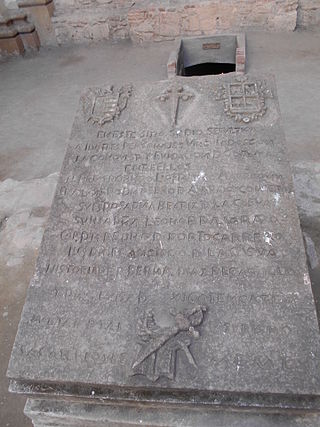
Pedro de Portocarrero was a Spanish conquistador who was active in the early 16th century in Guatemala, and Chiapas in southern Mexico. He was one of the few Spanish noblemen that took part in the early stages of the Spanish conquest of the Americas, and was distantly related to prominent conquistador Pedro de Alvarado, who appointed him as an official in early colonial Guatemala.
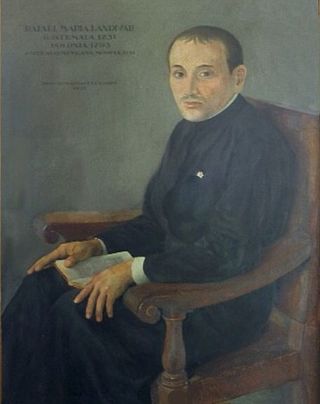
This article is about the poet and Jesuit priest; for the university see Rafael Landívar University